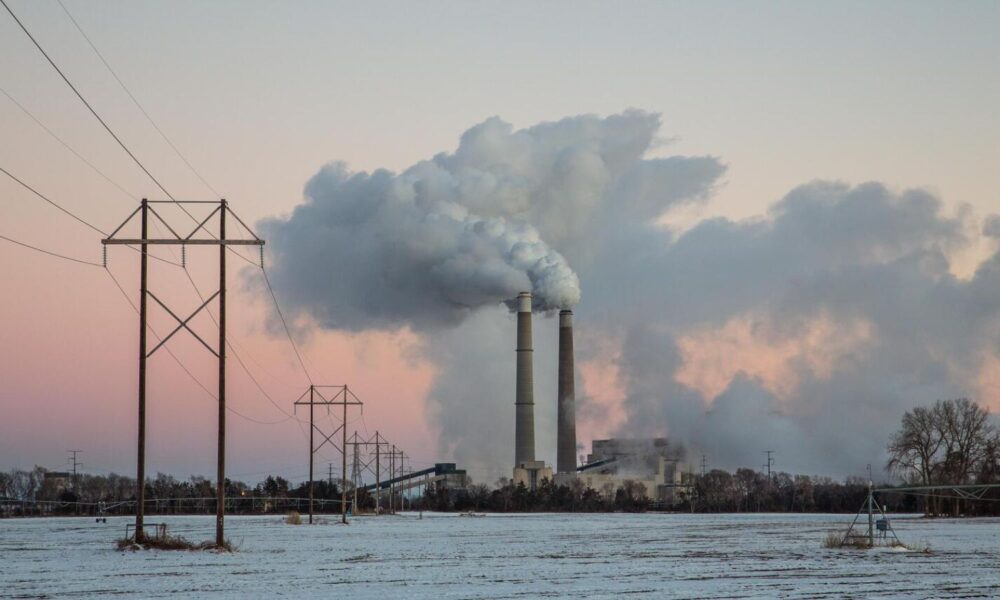
The U.S. Environmental Protection Agency (EPA) has introduced new regulations to reduce CO2 emissions from fossil fuel power plants. These rules target coal-fired plants and new natural gas facilities, aiming to push the industry toward cleaner operations. However, experts argue that failing to regulate existing gas plants limits the full potential of these reforms.
>> RELATED: Senators Seek Answers on EPA Effort to Claw Back $20 Billion in Climate Funds

How the New EPA Rules Work
The regulations require coal plants to either install carbon capture and storage (CCS) technology by 2032 or shift to natural gas co-firing by 2030, depending on their retirement plans. New natural gas plants operating as baseload power sources must also equip CCS by 2032.
However, existing natural gas plants are exempt from these strict requirements. Without regulations on older gas plants, the rules miss a major source of emissions, allowing inefficient facilities to continue polluting without major upgrades.
The Missed Potential for Greater Reductions
A study published in One Earth suggests that while the EPA’s rules could halve power sector emissions by 2040, they leave room for more reductions. Research from Princeton University’s ZERO Lab finds that regulating both new and existing gas plants under the same standards could significantly lower emissions at a lower cost per ton of CO2 avoided.
Jesse D. Jenkins, who leads Princeton’s ZERO Lab, highlighted this concern in a policy briefing: “The EPA’s current approach accelerates coal retirements but leaves a major loophole by not addressing existing gas plants, which could result in prolonged emissions.” The report stresses that without consistent regulations, existing gas plants will continue to be a major emissions source, undermining the full impact of the rules.

>> In Other News: Alberta Set to Build World's First Full-Sized Zero Carbon Cement Plant
Coal Plant Retirements Lead the Way
One of the biggest sources of emissions reductions under the new rules is the accelerated retirement of coal-fired power plants. Coal has been declining due to economic pressures, environmental policies, and the growth of renewables. The EPA’s stricter regulations will likely drive more shutdowns, further slashing emissions.
But if existing gas plants take the place of retired coal plants without stringent emissions controls, the gains could be offset. The lack of regulations for these plants could slow progress toward U.S. climate goals.
The Political Landscape and Uncertain Future
The battle over emissions rules is far from over. The EPA first attempted to regulate power plant emissions in 2014 under the Clean Power Plan (CPP), but the Supreme Court struck it down in 2022, ruling that the agency exceeded its authority.
In response, the Biden administration adopted a more targeted approach, setting plant-specific emission standards rather than broad, sector-wide limits. However, policy shifts remain a constant threat. Shortly after taking office in 2025, President Donald Trump ordered a review of the EPA’s new rules, raising concerns about possible rollbacks.
Qian Luo, co-author of the One Earth study, emphasized the risks of inconsistent policies, stating in a policy report: “A lack of stable, long-term policy frameworks discourages investment in clean energy solutions, slowing progress on emissions reductions.”
Strengthening the Rules for Maximum Impact
To ensure deeper and more cost-effective emissions cuts, experts suggest the following improvements to the EPA’s rules:
1. Regulate Existing Natural Gas Plants
Setting equal emission standards for all gas plants, regardless of age, would prevent inefficient plants from prolonging their lifespan.
2. Expand Incentives for Carbon Capture and Clean Energy
Additional funding and stronger incentives for CCS, renewables, and grid storage could accelerate the shift away from fossil fuels.
3. Ensure Long-Term Policy Stability
Avoiding constant regulatory changes would give companies confidence to invest in low-carbon technologies rather than delaying decisions.
The Bottom Line
The EPA’s 2024 power plant rules mark progress, but without including existing gas plants, they fall short of their full potential. By closing this gap, the U.S. could take a more effective and cost-efficient path toward cutting emissions, ensuring that all fossil fuel power plants are held to the same standard in the push for cleaner energy.
Subscribe to the newsletter
Daily decarbonization data and news delivered to your inbox
Follow the money flow of climate, technology, and energy investments to uncover new opportunities and jobs.
Latest issues
-
Can One Truck Fix Hydrogen’s Biggest Problem?
Inside This Issue 🚛 Alberta's Shared Truck Model Could Crack Hydrogen Adoption ✈️ ZeroAvia Completes Financing Round 🌾 Frontier And NULIFE Scale New Biowaste Carbon Removal Approach 🔥 WAGABOX® Of ...
-
North America’s Carbon Removal Year in Review: Winners, Losers, Surprises
Inside This Issue 🌎 North America's Carbon Removal Year in Review: The Deals, Policies, and Milestones That Shaped 2025 🚢 Hapag-Lloyd And North Sea Container Line Win ZEMBA Second E-Fuel Tender 🪨 ...
-
CCS Just Got Cheaper Than Anyone Expected
Inside This Issue 🧪 Shrinking the CCS Energy Penalty: A Molten Borate Breakthrough Promises Viability for Hard-to-Abate Canadian Oil & Gas 👤 Syntholene Energy Corp Appoints Former CEO of Carbo...
Company Announcements
-
WAGABOX® Of Steuben County, The First WAGABOX® Unit In The US
Deployment / Application Site Location: Bath, Steuben County, New York, USA Site/Plant name: Steuben County Landfill Partners/Clients: Steuben County (landfill owner), Corning Natural Gas (...
-
ZeroAvia Completes Financing Round
KEMBLE, UK and EVERETT, Wash., Dec. 22, 2025 /PRNewswire/ -- ZeroAvia today announced that it has completed a further round of financing, led by Barclays Climate Ventures, Breakthrough Energy Ventu...
-
CHARBONE Delivers Its First Load Of Clean UHP Hydrogen In Ontario
BROSSARD, QC, Dec. 22, 2025 /PRNewswire/ -- CHARBONE CORPORATION (TSXV: CH; OTCQB: CHHYF; FSE: K47) ("CHARBONE" or the "Company"), a North American producer and distributor specializing in clean Ul...
-
SÃO PAULO, BRAZIL, DECEMBER 17, 2025 – InPlanet, a pioneer in tropical Enhanced Rock Weathering (ERW), announced today that it has signed an agreement with Microsoft to remove more than 28,500 tonn...